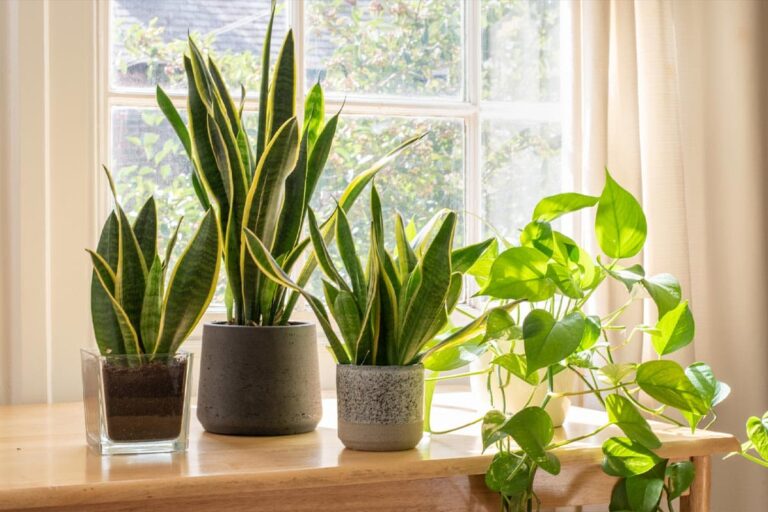The Best Air-Purifying Plants for a Healthier Home
Indoor Air Quality & Home Comfort

As outdoor temperatures begin to climb, you may look forward to staying in and beating the heat in your air-conditioned home. But what’s actually in the air your HVAC system is cranking out? Indoor pollutants can infiltrate the air you breathe without you even noticing. What if there was an easy, inexpensive, and even enjoyable way to mitigate pollution and improve indoor air quality?
There is! According to a NASA study, certain houseplants can help filter out potentially harmful airborne particles in your environment and contribute to cleaner air. Below, we’ll take a look at the benefits of adding potted plants to your home, how to care for them, and why doing so can be a big breath of fresh air for your environment (and your lungs).
Common Sources of Indoor Air Pollution
The air we all breathe, even indoor air, is never totally free from pollutants. Often, these microparticles are no big deal for individuals in good health, but they can exacerbate certain conditions in those with compromised immune systems. And some environments contain excessive levels of volatile organic compounds (VOCs) like trichloroethylene, formaldehyde, or benzene, which can be harmful to anyone. Consider the following factors and ask yourself how many VOCs may be entering the indoor air you’re breathing every day:
Household Products and Building Materials
Indoor air pollutants can be found in many products you use on a regular basis. If you’re in the midst of home improvements or any construction project, the risk is even greater. VOCs can be found in:
- Household cleaners and disinfectant
- Paint and paint thinner
- Caulks, silicone, and sealant
- Pesticides
- Flooring and carpeting
- New furniture
Everyday Activities and Appliances
Even when you’re not undertaking a home renovation or spring cleaning, you can still be exposed to indoor air pollution from surprising sources, which include:
- Toiletries like face cleansers, makeup, skincare, and perfumes
- Dry-cleaned clothing
- Craft supplies like glue, resins, and epoxies
- Copiers and printers
- Air fresheners
Environmental Factors
The environment around you plays as large of a role as the products you use. Remember that even pollutants that are primarily outdoors can still infiltrate your home. These can include:
- The way you heat and cool your home (natural gas, wood burning, etc.)
- Tobacco smoke and vaping residue
- Your proximity to traffic with gas and diesel emissions
- Surrounding manufacturers or factories
How Indoor Plants Improve Air Quality
Houseplants can help improve indoor air quality by filtering pollutants like benzene, toluene, and formaldehyde while increasing oxygen levels and humidity. They can also help regulate temperature, making your home more comfortable.
Beyond air quality, houseplants offer mental health benefits, reducing stress and boosting mood. Cleaner air can lead to improved concentration, better sleep, and an overall sense of calm. While they’re not a replacement for proper ventilation or air purifiers, adding greenery to your space is a simple and natural way to enhance your home’s atmosphere.
Best Indoor Plants for Air Purification
This all sounds great, but where do you begin? Plants are a low-cost and simple way to purify the air in your home, but if you aren’t familiar with types of plants or how to care for them, it can be an overwhelming prospect. Fortunately, bringing plants into your space is probably easier than you think. Here are some of the best houseplants you can pick:
Low-Maintenance Air-Purifying Plants for Beginners
Don’t have a green thumb? No worries. These beginner-friendly plants are pretty hardy, which makes them pretty hard to kill.
Spider Plant
A fast-growing plant that thrives in light shade. It produces small offshoots (“pups”) that can be easily replanted. Spider plants are known for filtering formaldehyde from the air.
Snake Plant (Mother-in-Law’s Tongue)
A nearly indestructible plant that tolerates both sun and shade. It helps remove toxins like xylene and nitrogen oxides and can also reduce allergens in the air.
Golden Pothos (Devil’s Ivy)
This hardy vine thrives in indirect light and helps filter out toxins like benzene and trichloroethylene. Caution: Golden pothos plants are toxic to cats and dogs.
ZZ Plant
ZZ plants can survive low light and drought, making them great for busy or forgetful plant owners. They help remove pollutants like ethylbenzene and xylene from indoor air.
Best Plants for Different Indoor Conditions
Many plants can be finicky about their location, but once you get them in the right spot, they can really take off. Consider placement before you pick your perfect plant.
Best for Bright Light: Aloe Vera
Perfect for kitchens, sunrooms, or near sunny windows. Aloe filters pollutants and contains soothing gel for burns.
Best for Cool, Shady Spots: Azalea
Great for basements or cool bedrooms, but make sure to choose greenhouse azaleas, as outdoor varieties don’t do well indoors.
Best for Low-Light Corners: Bamboo Palm
This bamboo-like plant thrives in dim areas and doesn’t need much sunlight. It does prefer moist soil, so check it regularly.
Best for Large, Bright Spaces: Rubber Plant
Rubber plants need plenty of indirect sunlight and are great for open living areas. They’re excellent air purifiers too!
Best for High Humidity Areas: Areca Palm
This tropical plant thrives in moisture and bright light, making it a great choice for a bathroom with good natural lighting.
Best for Hanging Baskets: Boston Fern
These love humidity and bright, indirect light. Boston ferns are great bathroom plants, but they need frequent watering to stay healthy.
Other Great Air-Purifying Plants & Flowers
There are many other houseplants that have been shown to have some air purification properties, including:
- Chrysanthemums
- Peace lily
- Gerbera daisy
- Weeping fig
- English ivy
- Philodendron
- Succulents
Breathe Easier with Airtron
Ready to clear the air? Pick your favorites from the list above and get growing! Of course, we know that air quality is a matter of health, and plants can’t do it alone. If you’re concerned about indoor air pollution, an air purifier or a high-efficiency HVAC system may be what you need. If you’ve got questions, Airtron has answers! Get in touch and let’s discuss how we can join forces to keep your air pure and clean!


